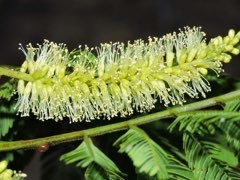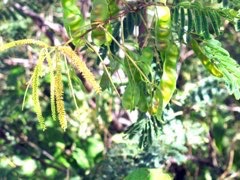 |
|
rubens-plantasdobrasil.blogspot.com.au |
 |
| rubens-plantasdobrasil.blogspot.com.au |
Translate this page:
Summary
Commonly found in northeastern part of Brazil, Piptadenia stipulacea is a spiny shrub belonging in the legume family. It is characterized by a small and rounded crown, and short and crooked bole that can be up to 25 cm in diameter. It grows about 3 - 5 m in height and becomes highly tolerant to drought once established. It is a fast-growing species and can be a potential weed in some areas. There is no known medicinal and edible uses of this plant but its wood has been used for fences, posts, and small constructions. It is also used for fuel and charcoal.
Physical Characteristics

 Piptadenia stipulacea is a deciduous Tree growing to 4 m (13ft) by 4 m (13ft) at a fast rate.
Piptadenia stipulacea is a deciduous Tree growing to 4 m (13ft) by 4 m (13ft) at a fast rate.
See above for USDA hardiness. It is hardy to UK zone 10. The flowers are pollinated by Insects.
It can fix Nitrogen.
Suitable for: light (sandy), medium (loamy) and heavy (clay) soils, prefers well-drained soil and can grow in nutritionally poor soil. Suitable pH: mildly acid, neutral and basic (mildly alkaline) soils. It cannot grow in the shade. It prefers dry or moist soil and can tolerate drought.
UK Hardiness Map
US Hardiness Map
Synonyms
Piptadenia communis stipulacea Benth. Pityrocarpa stipulacea (Benth.) Brenan
Plant Habitats
Edible Uses
References More on Edible Uses
Medicinal Uses
Plants For A Future can not take any responsibility for any adverse effects from the use of plants. Always seek advice from a professional before using a plant medicinally.
None known
References More on Medicinal Uses
The Bookshop: Edible Plant Books
Our Latest books on Perennial Plants For Food Forests and Permaculture Gardens in paperback or digital formats.

Edible Tropical Plants
Food Forest Plants for Hotter Conditions: 250+ Plants For Tropical Food Forests & Permaculture Gardens.
More

Edible Temperate Plants
Plants for Your Food Forest: 500 Plants for Temperate Food Forests & Permaculture Gardens.
More

More Books
PFAF have eight books available in paperback and digital formats. Browse the shop for more information.
Shop Now
Other Uses
Charcoal Containers Fencing Fuel Pioneer Wood
Agroforestry Uses:
A very fast-growing plant that is easy to propagate; succeeds in full sun; tolerates dry and infertile soils; fixes atmospheric nitrogen and rapidly invades open areas - it is a very good plant to use as a pioneer when restoring native woodland or when establishing a woodland garden[625
, K
].
Other Uses:
The wood is medium-textured, irregular to spiral-grained, heavy, hard to cut, very durable. A good wood, but generally only available in small sizes and so only used outdoors for fences, posts etc and indoors for small constructions[625
].
The wood is used for fuel and to make charcoal[625
].
Special Uses
Food Forest Nitrogen Fixer
References More on Other Uses
Cultivation details
A plant of the 'Caatinga' dry forest region of northeast Brazil. The climate is hot and dry, there are usually 6 to 11 months without rain each year. The mean annual rainfall varies from 250 - 1,000mm, and the mean annual temperature is from 24 - 26°c. Grows best in a sunny position[625 ]. Succeeds in dry soils and infertile soils[625 ]. Established plants are very drought tolerant[625 ]. The plant rapidly invades open areas and so is sometimes seen as a weed[625 ]. A very fast-growing plant[625 ]. This species has a symbiotic relationship with certain soil bacteria; these bacteria form nodules on the roots and fix atmospheric nitrogen. Some of this nitrogen is utilized by the growing plant but some can also be used by other plants growing nearby[755 ].
References Carbon Farming Information and Carbon Sequestration Information
Temperature Converter
Type a value in the Celsius field to convert the value to Fahrenheit:
Fahrenheit:
The PFAF Bookshop
Plants For A Future have a number of books available in paperback and digital form. Book titles include Edible Plants, Edible Perennials, Edible Trees,Edible Shrubs, Woodland Gardening, and Temperate Food Forest Plants. Our new book is Food Forest Plants For Hotter Conditions (Tropical and Sub-Tropical).
Shop Now
Plant Propagation
Seed - best sown as soon as it is ripe in a sunny position in a nursery seedbed. A high germination rate can be expected, with the seed sprouting within 10 - 20 days[625
].
Like many species within the family Fabaceae, once they have been dried for storage the seeds of this species may benefit from scarification before sowing in order to speed up and improve germination. This can usually be done by pouring a small amount of nearly boiling water on the seeds (being careful not to cook them!) and then soaking them for 12 - 24 hours in warm water. By this time they should have imbibed moisture and swollen - if they have not, then carefully make a nick in the seedcoat (being careful not to damage the embryo) and soak for a further 12 hours before sowing[K
].
Other Names
If available other names are mentioned here
Native Range
SOUTHERN AMERICA: Brazil (Bahia, Ceará, Distrito Federal, Espírito Santo, Pernambuco)
Weed Potential
Right plant wrong place. We are currently updating this section.
Please note that a plant may be invasive in one area but may not in your area so it's worth checking.
The plant rapidly invades open areas and so is sometimes seen as a weed[625 ].
Conservation Status
IUCN Red List of Threatened Plants Status : This taxon has not yet been assessed

Growth: S = slow M = medium F = fast. Soil: L = light (sandy) M = medium H = heavy (clay). pH: A = acid N = neutral B = basic (alkaline). Shade: F = full shade S = semi-shade N = no shade. Moisture: D = dry M = Moist We = wet Wa = water.
Now available:
Food Forest Plants for Mediterranean Conditions
350+ Perennial Plants For Mediterranean and Drier Food Forests and Permaculture Gardens.
[Paperback and eBook]
This is the third in Plants For A Future's series of plant guides for food forests tailored to
specific climate zones. Following volumes on temperate and tropical ecosystems, this book focuses
on species suited to Mediterranean conditions—regions with hot, dry summers and cool, wet winters,
often facing the added challenge of climate change.
Read More
Expert comment
Author
(Benth.) Ducke
Botanical References
Links / References
For a list of references used on this page please go here
A special thanks to Ken Fern for some of the information used on this page.
Readers comment
| Add a comment |
|
If you have important information about this plant that may help other users please add a comment or link below. Only comments or links that are felt to be directly relevant to a plant will be included. If you think a comment/link or information contained on this page is inaccurate or misleading we would welcome your feedback at [email protected]. If you have questions about a plant please use the Forum on this website as we do not have the resources to answer questions ourselves.
* Please note: the comments by website users are not necessarily those held by PFAF and may give misleading or inaccurate information.
To leave a comment please Register or login here All comments need to be approved so will not appear immediately.
|
Subject : Piptadenia stipulacea
|
|
|
|